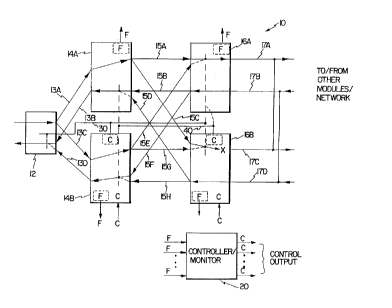Some of the information on this Web page has been provided by external sources. The Government of Canada is not responsible for the accuracy, reliability or currency of the information supplied by external sources. Users wishing to rely upon this information should consult directly with the source of the information. Content provided by external sources is not subject to official languages, privacy and accessibility requirements.
Any discrepancies in the text and image of the Claims and Abstract are due to differing posting times. Text of the Claims and Abstract are posted:
| (12) Patent: | (11) CA 2173367 |
|---|---|
| (54) English Title: | PROTECTION SWITCHING APPARATUS AND METHOD |
| (54) French Title: | PROCEDE ET APPAREIL DE COMMUTATION DE SECOURS |
| Status: | Deemed expired |
| (51) International Patent Classification (IPC): |
|
|---|---|
| (72) Inventors : |
|
| (73) Owners : |
|
| (71) Applicants : | |
| (74) Agent: | GOWLING WLG (CANADA) LLP |
| (74) Associate agent: | |
| (45) Issued: | 1999-09-07 |
| (86) PCT Filing Date: | 1994-10-04 |
| (87) Open to Public Inspection: | 1995-04-13 |
| Examination requested: | 1996-04-02 |
| Availability of licence: | N/A |
| (25) Language of filing: | English |
| Patent Cooperation Treaty (PCT): | Yes |
|---|---|
| (86) PCT Filing Number: | PCT/US1994/011266 |
| (87) International Publication Number: | WO1995/010146 |
| (85) National Entry: | 1996-04-02 |
| (30) Application Priority Data: | ||||||
|---|---|---|---|---|---|---|
|
A protection switching system (10) includes a plurality of telecommunications modules (12, 14A. 14B, 16A, 16B) for processing
and/or switching telecommunications signals. A first module (12) provides signals to one pair of modules (12A, 12B), which are in turn
connected to another pair of modules (16A, 16B). A standby module (14B, 16B) controls the switching of all the modules (12, 14A, 14B,
16A, 16B) in the system (10) which require switching in the event that a standby module (14B, 16B) is activated. A controller monitor
circuit (20) monitors the faults present on the working modules (14A, 16A) and, if a fault is detected, signals the corresponding standby
module (14B, 16B), which in turn provides protection switching.
Un système de commutation de secours (10) comprend une pluralité de modules de télécommunications (12, 14A, 14B, 16A, 16B) permettant de traiter et/ou de commuter des signaux de télécommunications. Un premier module (12) fournit des signaux à une paire de modules (12A, 12B) qui sont à leur tour connectés à une autre paire de modules (16A, 16B). Un module de réserve (14B, 16B) commande la commutation de tous les modules (12, 14A, 14B, 16A, 16B) du système (10) qui requièrent une commutation dans l'éventualité où un module de réserve (14B, 16B) serait activé. Un circuit de surveillance/commande (20) surveille les anomalies présentes sur les modules en service (14A, 16A), et, si une anomalie est détectée, la signale au module de réserve correspondant (14B, 16B), qui effectue à son tour une commutation de protection.
Note: Claims are shown in the official language in which they were submitted.
Note: Descriptions are shown in the official language in which they were submitted.

For a clearer understanding of the status of the application/patent presented on this page, the site Disclaimer , as well as the definitions for Patent , Administrative Status , Maintenance Fee and Payment History should be consulted.
| Title | Date |
|---|---|
| Forecasted Issue Date | 1999-09-07 |
| (86) PCT Filing Date | 1994-10-04 |
| (87) PCT Publication Date | 1995-04-13 |
| (85) National Entry | 1996-04-02 |
| Examination Requested | 1996-04-02 |
| (45) Issued | 1999-09-07 |
| Deemed Expired | 2002-10-04 |
There is no abandonment history.
| Fee Type | Anniversary Year | Due Date | Amount Paid | Paid Date |
|---|---|---|---|---|
| Application Fee | $0.00 | 1996-04-02 | ||
| Registration of a document - section 124 | $0.00 | 1996-06-27 | ||
| Maintenance Fee - Application - New Act | 2 | 1996-10-04 | $100.00 | 1996-09-13 |
| Maintenance Fee - Application - New Act | 3 | 1997-10-06 | $100.00 | 1997-09-17 |
| Maintenance Fee - Application - New Act | 4 | 1998-10-05 | $100.00 | 1998-09-17 |
| Final Fee | $300.00 | 1999-06-02 | ||
| Maintenance Fee - Patent - New Act | 5 | 1999-10-04 | $150.00 | 1999-09-20 |
| Maintenance Fee - Patent - New Act | 6 | 2000-10-04 | $350.00 | 2000-10-19 |
Note: Records showing the ownership history in alphabetical order.
| Current Owners on Record |
|---|
| ADC TELECOMMUNICATIONS, INC. |
| Past Owners on Record |
|---|
| OPOCZYNSKI, ADAM |